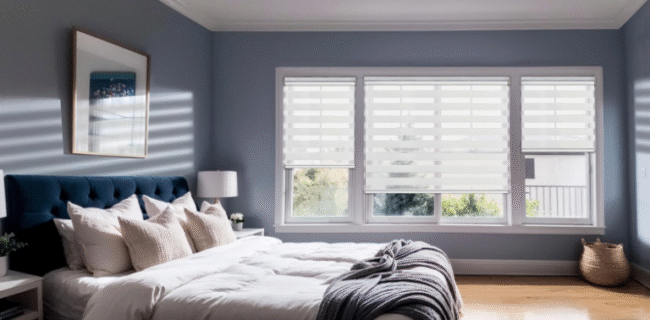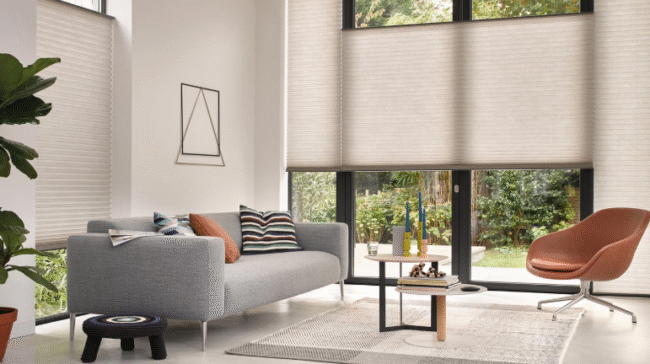How to Integrate Modern Blinds into Architectural Designs Without Compromising Aesthetics

When designing a contemporary area, it is important to balance functionality and visual appeal. Today’s blinds do more than just cover windows–they help with energy efficiency, privacy, and light control. The trick is to select designs that are compatible with the architectural style, and not against it. From stylish integrated blinds incorporated into glass to exterior blinds that can provide shade and security, contemporary alternatives can enhance the overall appearance. We’ll demonstrate how to incorporate blinds to different architectural styles – whether they’re minimalist interiors or huge glass facades, without sacrificing the clean modern look you’re seeking.
1- Understanding Different Architectural Designs
Understanding different architectural styles aids in selecting the best blinds that complement both function and style.
Modern Architecture
Modern architecture focuses on simple lines, spacious space, open areas and low decorations. It usually uses materials like steel, glass, or concrete. In these spaces integrated or motorized blinds are ideal since they keep the clean look and are a perfect match to the minimalist, practical style.
Contemporary Architecture
Contemporary architecture is more flexible and adaptive, and often reflects the latest developments in design and sustainability . It combines a variety of materials and emphasizes the natural sunlight.

Energy-efficient blinds suited for smart technology or a contemporary style—like thermal window blinds, would work perfectly since they balance style and environment.
Minimalist Architecture
Minimalism is all about simple, neutral colors and reducing visual noise. The focus is on function and space. Blinds with slim profiles, hidden mechanism, and neutral tones are the best for this design since they don’t detract from the clean, calm design.
2- Coordinating Blinds With Room Design Through Color and Material
Match the Blind Color with Wall or Trim
Choosing blinds in similar color to your walls or window trim creates a neat, unifying style. This is an ideal option for modern or minimalist designs and allows blinds to blend into the decor instead of standing out. It also helps maintain a sense of flow across the room, without visual distractions.
Use Contrast to Add Visual Interest
On the other hand, using a contrasting color could transform your blinds into an attractive design. For example, dark shades against light walls could create an impressive, stylish statement. This technique is ideal for rooms that require the presence of a focal point, or when you’d like to add an element of color without clashing with the room.
Choose Materials That Complement the Room’s Style
The material of the blinds should suit the room’s overall look and purpose. PVC or aluminium blinds are perfect for bathrooms and kitchens that are modern because of their strength and neat appearance. In contrast, natural wood or fabric blinds work well in living rooms as well in bedrooms where you want a warm and textured look.
3- Smart Blinds for a Cleaner Look
Smart blinds are a great way to keep things tidy. These days, smart options like zebra blinds come with motorized features that open and close at set times or adjust based on light levels, making them ideal for modern living. That means no need for cords or rods hanging from the sides — helping keep windows looking neat.
Smart blinds are useful in rooms with large windows or hard-to-reach areas. They’re also safer, especially in homes with children or pets.
4- Layer Blinds with Curtains for Softness
In certain cases blinds alone can create a space that is like it’s too simple. One option is to put curtains and blinds together. The blind will give you the control of the lighting and privacy, while the curtain gives color or texture.
For instance, in an open living space you can opt for a light roller shutter and soft curtains over. This combination will give the room a sense of depth, without making it feel heavy.
5- Make the Blind Part of the Window
Another great idea is to think of the blind as a part of the window. In some homes blinds are set within a frame that is matched to the window. It appears like an element that is part of the frame.
If your windows are fitted with specific features or trims opt for blinds that are compatible with the borders. It helps everything appear coordinated and connected.
6- Always Measure and Fit Properly
One of the most common mistakes in putting blinds on is the poor fit. A beautiful blind may look sloppy if it is unevenly or is either too large or small. Make sure you measure your windows accurately. If you require help, seek assistance from an expert.
Installing the blind within the window frame provides the appearance of a custom-designed, clean look. Outside-mount blinds are also a good option, but they look better when paired with curtains.
7- Use Built-in Blind Systems
One way to keep the design clean is to use built-in blinds. These are hidden inside the wall, ceiling, or window frame. When not in use, the blind disappears — leaving the window looking open and clear.
This works well in modern homes with a minimalist style. Built-in blinds don’t clutter the space. Many new homes are now being built with hidden spaces for blinds from the start. But even in older buildings, skilled builders can help add this feature.
Final Thoughts
Blinds do not have to mess up the style of your office or home. If they’re designed and installed correctly they can add style and comfort to any room. The key is to match them with the rest of the design — in terms of color, material form, and shape.
Whether you’re building a new home or updating an old space, blinds can be more than just a tool for shade. They can be part of the story your space tells. Think of them not as an extra, but as an important detail — one that brings beauty and usefulness together.
